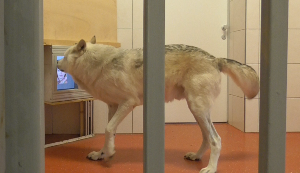Computer games for dogs and wolves
Nadine Groß (Animal trainer-trainee)
02.06.2020

Last year in spring, I came to the Wolf Science Center (WSC) to do my master thesis. With the data collection, a very educational and intense time accompanied by many challenges recently came to an end. The focus of my scientific internship was the project for my thesis: Emotion discrimination using the touch screen apparatus – a project that helps us examine if dogs and wolves, which were hand-raised and kept under identical conditions, are able to discriminate between happy and angry human faces. In this project, the animals worked on a touchscreen that displayed pictures divided in two parts. By doing so, two pictures could be presented and compared at the same time. By touching one side of the touchscreen with their nose, the animals were able to make a choice on the touchscreen.
But before the animals were confronted with the emotions, they had to pass through the first phase of the experiment – the so-called “pre-training”. In this early phase of the experiment, the dogs and wolves had to choose between a face with neutral expression and the back of the head. All animals were rewarded when choosing the face with neutral expression.
In this phase alone, we were already able to get an idea about the animals’ attitude, motivation and characteristics.
Both the dog Zuri and the wolf Chitto delivered brilliant achievements. In a minimum of time, they were able to reach the criterion to proceed to the next phase of the experiment. The learned very quickly and nothing could cause their concentration to alter.
The wolf Kenai needed just a little bit more time to do so. But he surprised us all with a unique result: In one session he was able to make 100% correct choices on the touchscreen! He not just enjoyed working on the touchscreen, he definitively understood what he had to do.
Kenai’s pack member Amarok was also always very impatient to be allowed to go to the test room. On each test day, Kenai and Amarok argued about who of them would be the first to go into the test room. But in comparison to Kenai, Amarok did not seem to be interested in solving the task on the touchscreen with flying colors. In fact, the fearless Amarok was way more interested in gnawing at the touchscreen, in jumping around like a kangaroo, and in trying to open some doors. I have to admit… Amarok’s sessions were… how should I say it… very rich in variety and adventurous!
The dog Asali also had some troubles to convince with his work on the touchscreen. Even though the task on the touchscreen appeared to be a mystery to him in the beginning, he never abandoned the field. In the face of wrong answers, he held his ground while trudging and grunting in front of the screen, waiting for the picture pairs to appear again. His unbridled will pushed him forward and helped him to achieve victory!
Another dog of ours showed a completely different attitude. Even though he was full of energy while going on walks, you could not find any of this vigor in the test room. I am talking about the slowest WSC dog working on the touchscreen: Hiari. While animals like the dog Enzi or the wolf Etu barrelled into the touchscreen like rockets, Hiari did his job on the touchscreen at a snail’s pace. Hiari moved towards the touchscreen in slow motion. After finally arriving in front of the screen (to do so, Hiari had to overcome a tremendous distance of two or maybe three steps), he froze. Nevertheless, if you watched him very carefully, you were able to see him rack his brain, while his eyes slowly moved from one picture to the other. He studied them patiently before making his choice. Did those careful considerations always cause a correct answer? No. Did he lose himself in thought sometimes? Yes. But even if you are a slow walker, you will arrive at some point.
The wolves Tekoa and Taima, also known as the “scared dwarfs”, as well as their brother Maikan, needed a little bit more time when they started participating. But the reason for that was not a lack of motivation. In the beginning, it took them some effort to enter the test room and to acclimate to the new test situation. However, they surprised us with their endless love for working with the touchscreen! Once they overcame their suspicion, they were in the zone and could not be stopped anymore. Especially Maikan, the smart cookie, proved himself while doing the tasks and outshined all the other animal participants.
With this touchscreen study, another project is slowly coming to an end that showed how much our animals enjoy and appreciate participating in a scientific test. Of course, science itself is a big motivation behind the projects as well. But our dogs and wolves really like to have some variation in their daily routine. Because of those tests, the animals are not just kept busy but are also mentally stimulated.
I really hope that such projects that move science forward and bring joy to our animals, will continue to happen at the WSC in the future as well!